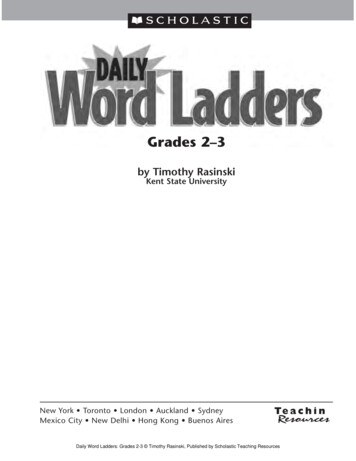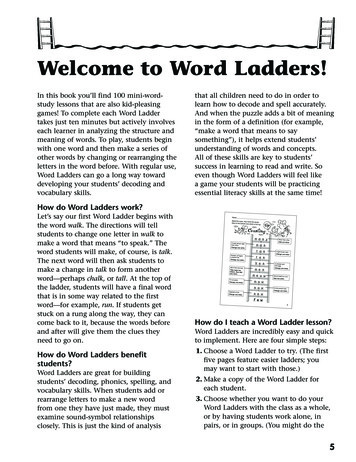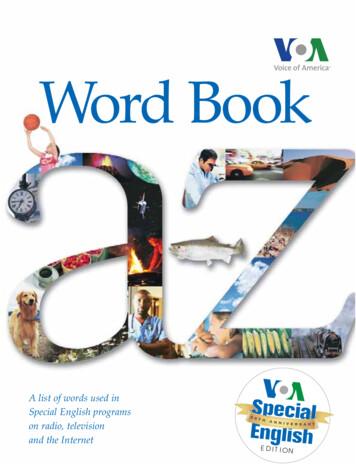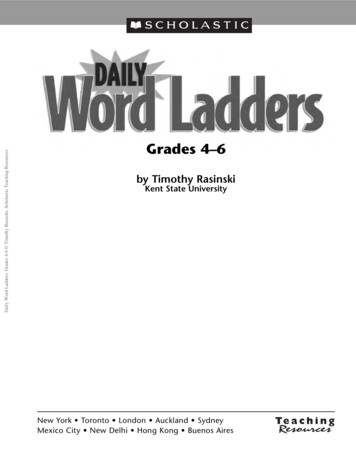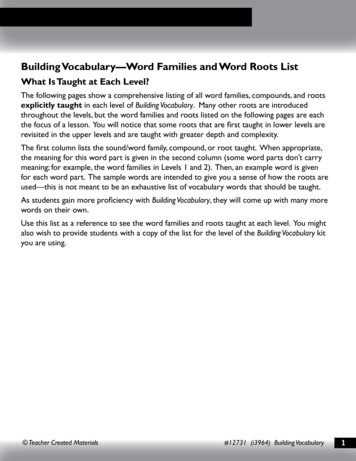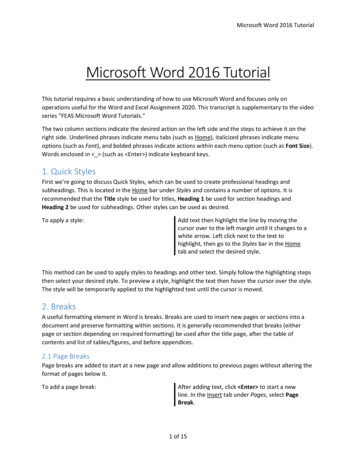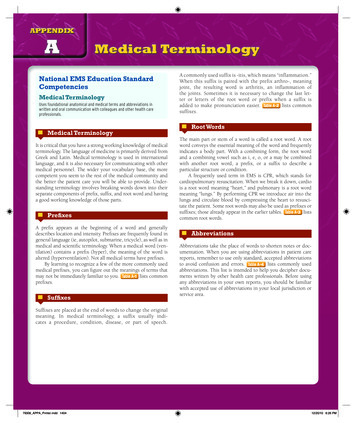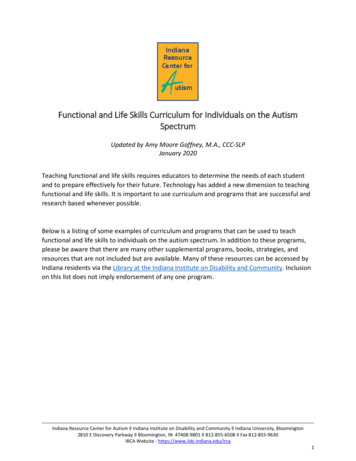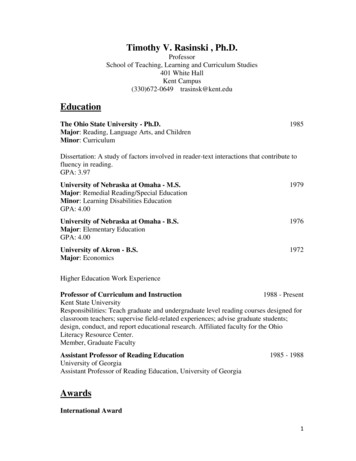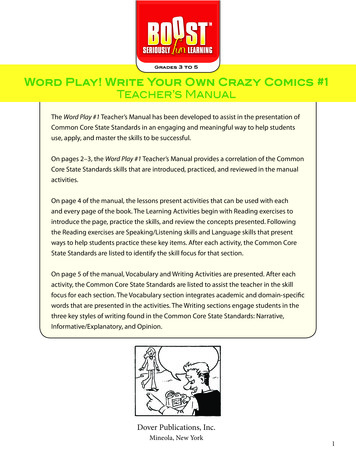
Transcription
Grades 3 to 5Word Play! Write Your Own Crazy Comics #1Teacher’s ManualThe Word Play #1 Teacher’s Manual has been developed to assist in the presentation ofCommon Core State Standards in an engaging and meaningful way to help studentsuse, apply, and master the skills to be successful.On pages 2–3, the Word Play #1 Teacher’s Manual provides a correlation of the CommonCore State Standards skills that are introduced, practiced, and reviewed in the manualactivities.On page 4 of the manual, the lessons present activities that can be used with eachand every page of the book. The Learning Activities begin with Reading exercises tointroduce the page, practice the skills, and review the concepts presented. Followingthe Reading exercises are Speaking/Listening skills and Language skills that presentways to help students practice these key items. After each activity, the Common CoreState Standards are listed to identify the skill focus for that section.On page 5 of the manual, Vocabulary and Writing Activities are presented. After eachactivity, the Common Core State Standards are listed to assist the teacher in the skillfocus for each section. The Vocabulary section integrates academic and domain-specificwords that are presented in the activities. The Writing sections engage students in thethree key styles of writing found in the Common Core State Standards: Narrative,Informative/Explanatory, and Opinion.Dover Publications, Inc.Mineola, New York1
Word Play! Write Your Own Crazy Comics # 1Teacher’s Manual LessonsCCSSCommon Core State StandardsRL.3.2 Recount stories, including fables, folktales, and myths from diverse cultures;determine the central message, lesson, or moral and explain how it is conveyed through keydetails in the text.RL.4.2 Determine a theme of a story, drama, or poem from details in the text; summarize thetext.ReadingLiterature orInformationalTextRL.5.2 Determine a theme of a story, drama, or poem from details in the text, including howcharacters in a story or drama respond to challenges or how the speaker in a poem reflectsupon a topic; summarize the text.RI.3.2 Determine the main idea of a text; recount the key details and explain how theysupport the main idea.RI.4.2 Determine the main idea of a text and explain how it is supported by key details;summarize the text.RI.5.2 Determine two or more main ideas of a text and explain how they are supported by keydetails; summarize the text.FoundationalSkillsRF.3.4, RF.4.4, RF.5.4 Read with sufficient accuracy and fluency to support comprehension.W.3.1 Write opinion pieces on familiar topics or texts, supporting a point of view withreasons.W.3.2 Write informative/explanatory texts to examine a topic and convey ideas andinformation clearly.W.3.3 Write narratives to develop real or imagined experiences or events using effectivetechnique, descriptive details, and clear event sequences.W.3.5, W.4.5 With guidance and support from peers and adults, develop and strengthenwriting as needed by planning, revising, and editing.W.3.7 Conduct short research projects that build knowledge about a topic.WritingW.3.8 Recall information from experiences or gather information from print and digitalsources; take brief notes on sources and sort evidence into provided categories.W.4.1, W.5.1 Write opinion pieces on topics or texts, supporting a point of view with reasonsand information.W.4.2 Write informative/explanatory texts to examine a topic and convey ideas andinformation clearly.W.4.3 Write narratives to develop real or imagined experiences or events using effectivetechnique, descriptive details, and clear event sequences.W.4.7 Conduct short research projects that build knowledge about a topic.W.4.8 Recall relevant information from experiences or gather relevant information from printand digital sources; take notes and categorize information, and provide a list of sources.W.5.2 Write informative/explanatory texts to examine a topic and convey ideas andinformation clearly.2
Word Play! Write Your Own Crazy Comics # 1W.5.3 Write narratives to develop real or imagined experiences or events using effectivetechnique, descriptive details, and clear event sequences.W.5.5 With guidance and support from peers and adults, develop and strengthen writing asWriting,continuedneeded by planning, revising, editing, rewriting, or trying a new approach.W.5.7 Conduct short research projects that use several sources to build knowledge throughinvestigation of different aspects of a topic.W.5.8 Recall relevant information from experiences or gather relevant information from printand digital sources; summarize or paraphrase information in notes and finished work, andprovide a list of sources.SL.3.1, SL.4.1, SL.5.1 Engage effectively in a range of collaborative discussions (one-on-one,in groups, and teacher-led) with diverse partners on grade 3 (grades 4 and 5) topics and texts,building on others’ ideas and expressing their own clearly.SL.3.4 Report on a topic or text, tell a story, or recount an experience with appropriate factsSpeaking andListeningand relevant, descriptive details, speaking clearly at an understandable pace.SL.4.4 Report on a topic or text, tell a story, or recount an experience in an organizedmanner, using appropriate facts and relevant, descriptive details to support main ideas orthemes; speak clearly at an understandable pace.SL.5.4 Report on a topic or text or present an opinion, sequencing ideas logically and usingappropriate facts and relevant, descriptive details to support main ideas or themes; speakclearly at an understandable pace.L.3.1, L.4.1, L.5.1 Demonstrate command of the conventions of standard English grammarand usage when writing or speaking.L.3.2, L.4.2, L.5.2 Demonstrate command of the conventions of standard EnglishLanguagecapitalization, punctuation, and spelling when writing.L.3.5 Demonstrate understanding of word relationships and nuances in word meanings.L.4.5, L.5.5 Demonstrate understanding of figurative language, word relationships, andnuances in word meanings.3
Word Play! Write Your Own Crazy Comics # 1SummaryThe book is filled with comic strips for students to complete by adding dialogue to the speech bubbles.Introduce the Book Display a humorous comic strip from a newspaper. Discuss the comic strip genre and itsfeatures with students. Be sure students describe how the story line is sequenced and toldthrough speech bubbles and illustrations. (SL.3.4, SL.4.4, SL.5.4) Have students read and discuss the Note at the front of the book. Then together withstudents complete the comic on page 1 after discussing the title and the panels and usingthat discussion to help generate dialogue for the speech bubbles. (RF.3.4.a, W.3.3.b, RF.4.4.a,W.4.3.b, RF.5.4.a, W.5.3.b)Present a Reading Routine Have students work with small groups or partners to plan and write the dialogue for thecomics. Have groups or pairs take turns displaying and reading aloud one of their comicstrips. Remind readers to read with expression. (RF.3.4.b, W.3.3.b, RF.4.4.b, W.4.3.b, RF.5.4.b,W.5.3.b)LearningActivitiesProvide Activities for Reading Some of the comics provide comical ideas to a theater (page 35) and a play (page 45) with astory. Ask students to think about a favorite story. Have them retell an exciting event, a keypart of the plot, or central message of the story. If time permits, students can read a favoritesection of the story. (RL.3.2, RL.4.2, RL.5.2) Many of the titles for the comics are topics discussed in informational texts. Have studentsreview the titles and choose one, such as Baseball, Computer, Desert, and Eagle, they wouldlike to read about. Have them choose an informational text from the classroom or schoollibrary. After students have read the text, have them first summarize the text and thenidentify its main idea or ideas and explain how key details provide support. (RI.3.2, RI.4.2,RI.5.2)Focus on Language Arts Speaking/Listening: Choose one of the professions or occupations, such as BBQ on page6 (chef), Homework on page 29 (teacher), and Moon on page 34 (astronaut), featured inthe comics and ask students to do research about the profession or occupation. Encouragethem to find information about educational requirements and work responsibilities.Have students draw on their research information as you explore the topic in a classroomdiscussion. (SL.3.1.a, SL.4.1.a, SL.5.1.a) Language Skills: Have students work with partners to proofread the copy in the speechbubbles for grammar and spelling. Encourage them to consult dictionaries as necessary tocheck for the correct spelling of words. (W.3.5, L.3.1, L.3.2.g, W.4.5, L.4.1, L.4.2.d, W.5.5,L.5.1, L.5.1.e)4
Word Play! Write Your Own Crazy Comics # 1VocabularySummaryHave students use the following activity to develop vocabulary by identifying the literal and nonliteral meaningsof idioms.VocabularyActivitiesIdiomsRemind students that an idiom is a phrase or sentence whose meaning cannot beunderstood by the meaning of the individual words. Provide examples, such as “stepon it.” Discuss the literal and nonliteral meanings of the phrase: literal—“put a footdown on something”; nonliteral (idiom)—“speed up.” Have students look for idiomsin a partner’s comics and explain their literal and nonliteral meanings. Alternatively,students could suggest idioms that could be used in a comic to add humor. (L.3.5.a,L.4.5.b, L.5.5.b)WritingSummaryHave students develop their writing skills by completing the following activities.Narrative WritingMost of the comics provide an opportunity to write dialogue for a short sequenceof events. Have students choose one of the comics and extend the story line bydeveloping the plot to include events before and after those depicted in the comic.Explain that students can use a traditional story format that establishes a situation,introduces characters, and organizes a sequence of events through dialogue anddescriptions that show characters’ reactions to events. They might choose instead toextend the story using the graphic novel approach that relies heavily on pictures andspeech bubbles to relate the events of the story. (W.3.3.a, W.3.3.b, W.3.3.c, W.4.3.a,W.4.3.b, W.4.3.c, W.4.3.d, W.5.3.a, W.5.3.b, W.5.3.c, W.5.3.d)WritingActivitiesInformative/Explanatory WritingHave students choose one of the titles of the comics, such as Baseball on page 5,Bowling on page 9, Desert on page 18, Fireflies on page 25, and Moon on page 34,and use that title as the topic for a written informational report. Explain that theyshould introduce and develop the topic, use words and phrases to link ideas, useprecise language, and provide a conclusion. Ask students to use at least one printsource and one online source of information and to list their sources at the endof their report. (W.3.2.a, W.3.2.b, W.3.2.c, W.3.2.d, W.3.7, W.3.8, W.4.2.a, W.4.2.b,W.4.2.c, W.4.2.d, W.4.2.e, W.4.7, W.4.8, W.5.2.a, W.5.2.b, W.5.2.c, W.5.2.d, W.5.2.e,W.5.7, W.5.8)Opinion WritingHave students review their comics and choose one they believe is particularlyhumorous. Ask them to write a short opinion paper identifying why they thinkthe comic is humorous. Remind students that they should introduce their topic,state their opinion about it, and provide an organizational structure for listing thereasons that support their opinion. Encourage them to use linking words to connectideas and to write a concluding statement related to the opinion. (W.3.1.a, W.3.1.b,W.3.1.c, W.3.1.d, W.4.1.a, W.4.1.b, W.4.1.c, W.4.1.d, W.5.1.a, W.5.1.b, W.5.1.c,W.5.1.d)Visit BOOST Product Page5
2 Word Play! Write Your Own Crazy Comics # 1 Teacher’s Manual Lessons Reading Literature or Informational Text RL.3.2 Recounstorncluding fables, folktales, anmythfrom diverscultures; t
